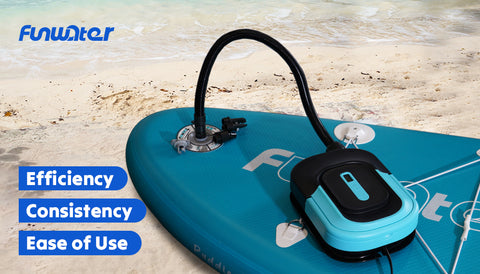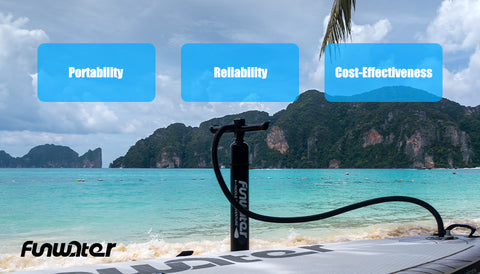Electric vs Manual Paddle Board Pumps: Which is Right for You
Paddleboarding has surged in popularity in recent years, captivating adventure seekers and water enthusiasts alike. Whether you're cruising along serene lakeshores or riding the waves of the open ocean, having the right equipment is essential for an enjoyable experience. One critical piece of equipment is the pump used to inflate your paddleboard. But when it comes to paddle board pumps, there's a choice to be made: electric or manual? In this guide, we'll dive deep into the pros and cons of each to help you decide which type of pump suits your needs best.

Electric Paddle Board Pumps: Effortless Inflation
Electric paddle board pumps have revolutionized the way we inflate our boards. With the simple press of a button, these pumps do the hard work for you, rapidly inflating your paddleboard to the desired pressure. Here's a closer look at the advantages and considerations of electric pumps:
- Pros
Efficiency: Perhaps the most significant advantage of electric pumps is their efficiency. They can inflate a paddleboard much faster than manual pumps, saving you time and energy, especially if you have multiple boards to inflate or are in a hurry to hit the water.
Consistency: Electric pumps provide consistent pressure, ensuring that your paddleboard is uniformly inflated to the manufacturer's recommended PSI (pounds per square inch). This consistency is crucial for optimal performance and stability on the water.
Ease of Use: Operating an electric pump is incredibly straightforward. Most models come with intuitive controls, making them accessible even for beginners. Simply attach the hose to your paddleboard, select the desired pressure setting, and let the pump do its job.

- Considerations
Power Source: Electric pumps require a power source, usually a standard electrical outlet or a portable power supply. While this isn't typically an issue at home or near a vehicle, it can be limiting if you're inflating your board in remote locations without access to electricity.
Cost: Electric pumps tend to be more expensive upfront compared to manual pumps. However, if you value convenience and time savings, the investment may be well worth it in the long run.
Portability: While electric pumps are generally more compact and portable than their manual counterparts, they still require additional equipment such as power cords or batteries. Consider how easily you can transport the pump, especially if you frequently paddle in remote or off-grid locations.

Manual Paddle Board Pumps: Traditional Versatility
Manual paddle board pumps have been a staple in the paddleboarding community for years, offering a reliable and versatile inflation solution. While they may require a bit more effort compared to electric pumps, they come with their own set of advantages:
- Pros
Portability: One of the biggest advantages of manual pumps is their portability. Since they don't rely on electricity or batteries, you can take them anywhere your adventures lead, whether it's a remote beach or a backcountry lake.
Reliability: Manual pumps are incredibly reliable, with no risk of mechanical malfunctions or power outages. As long as you have the pump and a bit of elbow grease, you can inflate your paddleboard wherever and whenever you choose.
Cost-Effectiveness: Manual pumps are generally more affordable than electric pumps, making them an attractive option for budget-conscious paddlers. Additionally, they require minimal maintenance and have fewer components that can wear out over time.
- Considerations
Effort Required: The primary drawback of manual pumps is the physical effort required to inflate your paddleboard. Depending on your fitness level and the size of your board, it can take significant time and energy to reach the desired pressure.
Inflation Time: Manual pumps typically take longer to inflate a paddleboard compared to electric pumps. This can be a drawback if you're in a hurry or have multiple boards to inflate.
Pressure Consistency: Achieving consistent pressure with a manual pump can be challenging, especially for beginners. It may take some trial and error to find the right technique and ensure that your paddleboard is properly inflated.

Choosing the Right Pump for You
Ultimately, the decision between an electric and manual paddle board pump boils down to your personal preferences, budget, and specific needs. If you value convenience, efficiency, and don't mind the higher upfront cost, an electric pump may be the way to go. On the other hand, if you prioritize portability, reliability, and cost-effectiveness, a manual pump might be the better option.
Consider where and how often you paddle, your physical capabilities, and your budget constraints when making your decision. Whichever type of pump you choose, investing in a high-quality pump from a reputable brand will ensure years of reliable performance and countless memorable paddleboarding adventures. So, whether you opt for the ease of an electric pump or the versatility of a manual pump, get ready to hit the water and experience the exhilarating thrill of paddleboarding to the fullest.























































































































































Leave a comment